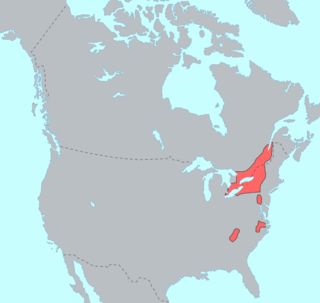
New France was the area colonized by France in North America, beginning with the exploration of the Gulf of Saint Lawrence by Jacques Cartier in 1534 and ending with the cession of New France to Great Britain and Spain in 1763 under the Treaty of Paris.

United Empire Loyalists is an honorific title which was first given by the 1st Lord Dorchester, the Governor of Quebec, and Governor General of The Canadas, to American Loyalists who resettled in British North America during or after the American Revolution. At the time, the demonym Canadian or Canadien was used to refer to the indigenous First Nations groups and the descendants of New France settlers inhabiting the Province of Quebec.

The Beaver Wars, also known as the Iroquois Wars or the French and Iroquois Wars, encompass a series of conflicts fought intermittently during the 17th century in North America throughout the Saint Lawrence River valley in Canada and the lower Great Lakes region which pitted the Iroquois against the Hurons, northern Algonquians and their French allies. As a result of this conflict, the Iroquois destroyed several confederacies and tribes through warfare: the Hurons or Wendat, Erie, Neutral, Wenro, Tionontate, Susquehannock, Mahican and northern Algonquins whom they defeated and dispersed, some fleeing to neighboring peoples and others assimilated, routed, or killed.

Events from the 15th century in Canada.

Events from the 1600s in Canada.

Events from the 1610s in Canada.

Events from the 1640s in Canada.

Events from the 1650s in Canada.

Events from the 1660s in Canada.

Events from the 1680s in Canada.

Events from the 1690s in Canada.

The Iroquoian languages are a language family of indigenous peoples of North America. They are known for their general lack of labial consonants. The Iroquoian languages are polysynthetic and head-marking.

Jacques-René de Brisay de Denonville, Marquis de Denonville was Governor General of New France from 1685 to 1689 and was a key figure in the Beaver Wars.

Gabriel Lalemant was a French Jesuit missionary in New France beginning in 1646. Caught up in warfare between the Huron and nations of the Iroquois Confederacy, he was killed in St. Ignace by Mohawk warriors and is one of the eight Canadian Martyrs.

Daniel de Rémy de Courcelle, Sieur de Montigny, de La Fresnaye et de Courcelle was the Governor General of New France from 1665 to 1672.

Fort Richelieu is a historic fort in La Vallée-du-Richelieu Regional County Municipality, Quebec, Canada. The fort is designated as a National Historic Site of Canada. Fort Richelieu was part of a series of five forts built along the Richelieu River and is at the mouth of the Richelieu River. Fort Chambly formerly known as Fort St. Louis at Chambly, Fort Sainte-Thérèse, and Fort Saint-Jean at Saint-Jean-sur-Richelieu, are on the way. Fort Sainte Anne (Vermont) on Isle La Motte, Vermont in Lake Champlain is near its source. The forts were built in order to protect travellers on the river from the Iroquois. The region is informally known as la Vallée-des-Forts.

The Iroquois, Haudenosaunee, or Ongweh’onweh, are an Iroquoian-speaking confederacy of First Nations peoples in northeast North America/Turtle Island. They were known during the colonial years to the French as the Iroquois League, and later as the Iroquois Confederacy. The English called them the Five Nations, comprising the Mohawk, Oneida, Onondaga, Cayuga, and Seneca. After 1722, the Iroquoian-speaking Tuscarora people from the southeast were accepted into the confederacy, which became known as the Six Nations.

Jesuit missions in North America were attempted in the late 16th century, established early in the 17th century, faltered at the beginning of the 18th, disappeared during the suppression of the Society of Jesus around 1763, and returned around 1830 after the restoration of the Society. The missions were established as part of the colonial drive of France and Spain during the period, the "saving of souls" being an accompaniment of the constitution of Nouvelle-France and early New Spain. The efforts of the Jesuits in North America were paralleled by their China missions on the other side of the world, and in South America. They left written documentation of their efforts, in the form of The Jesuit Relations.

In 1666, the French built a fort, on Isle La Motte, to protect Canada from the Iroquois. The fort was dedicated to Saint Anne. Fort Sainte Anne was the most vulnerable to attacks by the Iroquois, because it was the last of five forts stretching along the Richelieu River going south. The other four were Fort Richelieu, Fort Chambly, Fort Sainte Thérèse and Fort Saint-Jean.
Alexandre de Prouville de Tracy had the forts built by four companies of the Carignan-Salières Regiment. The first three forts were built in 1665, and the other two in 1666. By the end of 1665, three of the five Iroquois Nations made peace in Quebec City. The Canadien Governor, Daniel de Courcelle, sent Tracy in the Fall of 1666 with 1,200 men, along with Hurons and Algonquins to attack the two Iroquois Nations resisting, the Mohawks and the Oneidas. The Mohawks ran away into the forest, and the following year, peace was made with the two Nations. The peace continued for seventeen years.
The Little Iroquois River is a tributary of the Iroquois River, flowing in Notre Dame Mountains, the Madawaska County, in Northwest of New Brunswick, in Canada.











